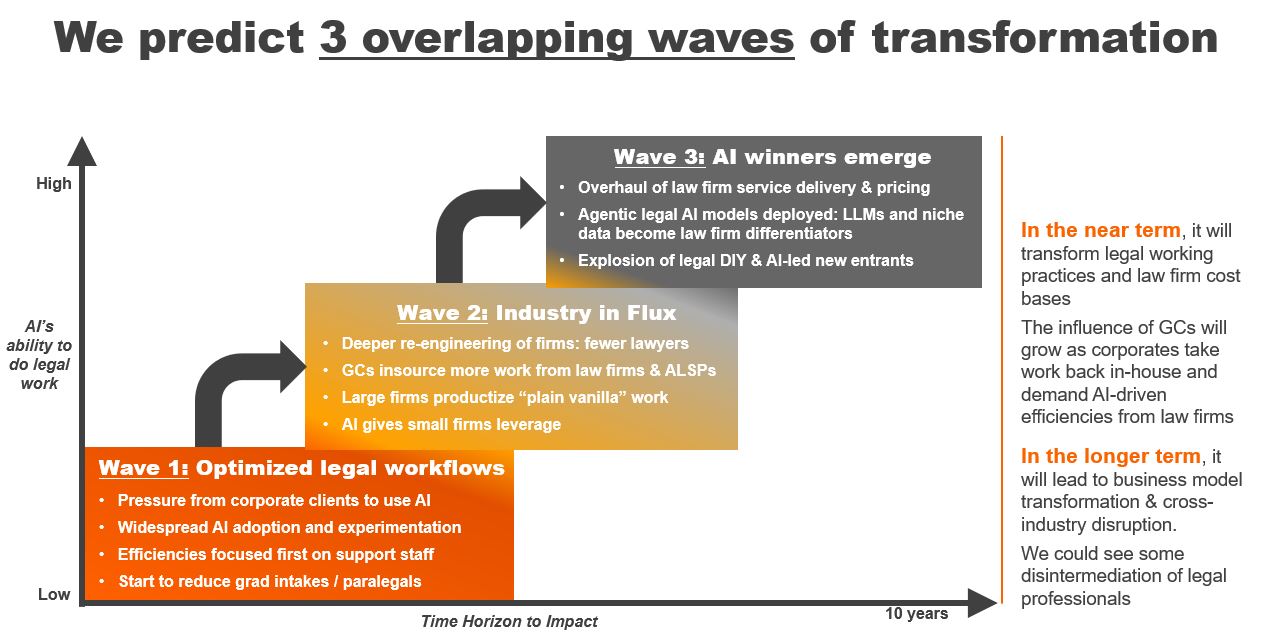Gen AI is a game-changing technology, directly impacting the way legal work is done and the current law firm-client business model; while much remains unsettled, within 10 years, Gen AI is likely to change corporate legal departments and law firms in profound and unique ways
Generative Artificial Intelligence (Gen AI) is no longer a distant dream but a present reality, already leaving its mark on the legal sector. Its adoption across corporate legal departments and law firms of varying sizes marks the beginning of a significant transformation, driven by tools like ChatGPT, Microsoft’s Copilot, and sector-specific innovations. This shift from experimentation to strategic implementation underscores the legal community’s recognition of the impending transformation. A staggering 70% of legal professionals foresee AI and Gen AI dramatically influencing the legal profession within five years, surpassing other trends such as economic shifts, regulatory changes, and ESG initiatives, as highlighted in the Thomson Reuters Future of Professionals Report.
The legal industry stands on the brink of a paradigm shift, with Gen AI acting as the catalyst for imminent and extensive changes in business models and the potential for lawyer disintermediation in favor of technological solutions. The forward-thinking legal entities are not merely dabbling in Gen AI but are strategically preparing for a future that promises to be vastly different by 2034.
Our predictions for AI in the legal industry
To understand how the industry could be impacted by AI in the near and longer term, we garnered the views of Thomson Reuters’s technology and legal market experts, including members of TR Labs, who are at the cutting edge of legal AI research and development. We also interviewed a range of experts across industry and academia. Based on these discussions and other research recently conducted by Thomson Reuters, such as our Future of Professionals Survey, we have been able to make early predictions for how the legal market will evolve over the next decade.

The Integration of Gen AI: Three Overlapping Three Waves of Transformation
Wave 1: Optimized Legal Workflows
The onset of the first wave is already visible, with a surge in AI adoption and experimentation across the legal sector. This early phase, spanning the next one to three years, marks a pivotal shift from theoretical exploration to practical application of Gen AI tools. Legal departments and firms are beginning to harness these technologies to streamline back-office operations and support functions. This strategic move aims to optimize labor costs, significantly reducing the reliance on new associate hires and non-fee-earning staff. The focus is squarely on enhancing efficiency in routine tasks, setting the stage for more profound changes in the legal workflow and cost structure.
Wave 2: Industry in Flux
As we progress into the second wave, spanning three to five years, the legal industry will encounter a dynamic shift. The advancement of Gen AI technologies enables the handling of increasingly complex tasks, catalyzing a transformation in the legal business model. During this period, corporate legal departments, led by General Counsels (GCs), will start to insource more work traditionally outsourced to law firms and Alternative Legal Service Providers (ALSPs). This shift is driven by the enhanced efficiency Gen AI brings, allowing legal work to be completed more swiftly and effectively.
The pressure from corporate clients on law firms and external providers will intensify, demanding faster delivery of legal services. This demand for speed and efficiency challenges the traditional billable hour model, prompting law firms to rethink their billing strategies. The goal is to capture the value added through technology, sharing in the efficiency savings. This wave sees a re-engineering of legal firms, with a move towards fewer lawyers and a greater emphasis on leveraging AI for high-value tasks. Large law firms will seek to capitalize on this by deploying staff to more strategic work, while small and midsize firms use AI to expand their practices without increasing headcount. The imperative for change becomes clear: adapt or risk being left behind.
Already, Gen AI has begun to make in-roads among law firms, corporate legal departments, and other legal service providers and technology companies.
Wave 3: AI Winners Emerge
Looking further ahead, five to ten years into the future, the legal industry will undergo a comprehensive transformation. This third wave is characterized by the widespread automation of legal services and, in some scenarios, the partial or full disintermediation of legal professionals through AI. Gen AI’s capability to tackle complex legal tasks will make it a primary driver of day-to-day operations, with legal practitioners shifting to supervisory and strategic roles.
This wave heralds a complete overhaul of how legal services are delivered and billed. The emergence of tech-enabled services and DIY legal solutions will enable some clients, both in the public and corporate spheres, to bypass traditional law firms entirely. This shift increases access to justice in underserved markets and challenges law firms to innovate, blending AI with human expertise to meet the expectations of a clientele accustomed to and expectant of AI-enabled services. The landscape will be marked by a new mix of players, with AI-driven firms and technologies leading the charge in redefining legal service delivery.
Gen AI’s rollout looks different based on organizational type
However, as noted above, not all parties in the legal industry will fully embrace Gen AI’s introduction, nor will the technology’s advancement affect everyone equally. Gen AI will impact differently-sized corporate legal departments and law firms unevenly.
Corporate Legal Departments
At the forefront, corporate legal departments are leveraging Gen AI in transformative ways, potentially reshaping their structure and daily operations. The adoption of Gen AI on an enterprise scale offers these departments significant advantages, including economies of scale and substantial technology investments. However, as these departments face ongoing cost pressures, a notable shift is expected within their internal roles. Tasks traditionally handled by paralegals and junior staff are becoming automated, leading to a reduction in these positions.
Moreover, corporate legal departments are increasingly demanding lower costs from their external legal service providers, especially for tasks considered low-stakes. This pressure may result in a shift away from traditional panel firms to alternative legal service providers (ALSPs) or technology firms that have embraced AI, underscoring the necessity for legal service providers to adapt to remain competitive. This focus on cost-efficiency is likely to encourage the adoption of alternative fee arrangements, further diminishing the reliance on the billable hour model.
This shift towards cost-cutting and a change of roles is likely to be mirrored across law firms of all sizes.
Law Firms
The impact of Gen AI extends across law firms of all sizes, each facing its own set of challenges and opportunities.
- Large Law Firms: With greater technological capabilities and access to larger datasets, large law firms are in a prime position to innovate. Many have already established new law or internal innovation teams, focusing on leveraging niche data as a key differentiator in the age of AI. These firms might also use Gen AI to develop technology products that make previously unprofitable work viable, capitalizing on their economies of scale.
- Midsize Law Firms: For midsize firms, Gen AI offers a chance to automate repetitive, labor-intensive tasks, allowing them to take on more clients or expand their practice areas. This technological leverage can position them as cost-effective alternatives for standard transactions or disputes, enabling growth without proportionally increasing their workforce.
- Small Law Firms: Similarly, small law firms can utilize Gen AI to automate certain processes, reducing the need for new hires while allowing for business expansion. This not only aids in firm growth but also contributes to addressing the access to justice issue, as more consumers can afford legal services.
Conclusion
While there’s much speculation about how and when Gen AI will change the legal profession, influenced by its development, the industry’s response, and external pressures, it’s clear there are many possible directions for its impact. Despite the uncertainties, it’s wise for law firms, corporate legal departments, ALSPs, and other legal industry players to start planning for a future shaped by Gen AI now. It’s likely that Gen AI will bring significant changes to how we work, making early preparation essential for adapting to this evolving landscape.
How Thomson Reuters Southeast Asia can help
Elevate your legal practice with Thomson Reuters Southeast Asia’s premier suite of solutions. Dive into our innovative tools like HighQ, Practical Law, Legal Tracker, and Westlaw to streamline your operations and gain critical insights. Plus, get ready for our upcoming AI-enabled tools designed to revolutionize legal departments with smarter, faster decision-making capabilities.
Ready to transform your legal strategy? Request a free demo or trial, connect with us on LinkedIn, and subscribe to our Newsletter for the latest in legal innovation.


